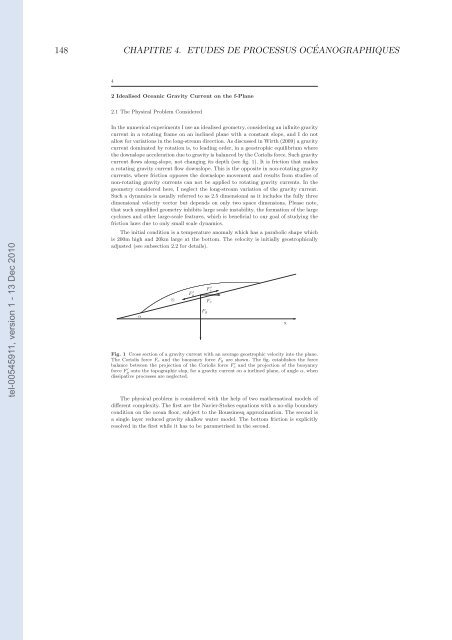Etudes et évaluation de processus océaniques par des hiérarchies ...
Etudes et évaluation de processus océaniques par des hiérarchies ...
Etudes et évaluation de processus océaniques par des hiérarchies ...
Create successful ePaper yourself
Turn your PDF publications into a flip-book with our unique Google optimized e-Paper software.
148 CHAPITRE 4. ETUDES DE PROCESSUS OCÉANOGRAPHIQUES<br />
4<br />
2 I<strong>de</strong>alised Oceanic Gravity Current on the f-Plane<br />
2.1 The Physical Problem Consi<strong>de</strong>red<br />
tel-00545911, version 1 - 13 Dec 2010<br />
In the numerical experiments I use an i<strong>de</strong>alised geom<strong>et</strong>ry, consi<strong>de</strong>ring an infinite gravity<br />
current in a rotating frame on an inclined plane with a constant slope, and I do not<br />
allow for variations in the long-stream direction. As discussed in Wirth (2009) a gravity<br />
current dominated by rotation is, to leading or<strong>de</strong>r, in a geostrophic equilibrium where<br />
the downslope acceleration due to gravity is balanced by the Coriolis force. Such gravity<br />
current flows along-slope, not changing its <strong>de</strong>pth (see fig. 1). It is friction that makes<br />
a rotating gravity current flow downslope. This is the opposite in non-rotating gravity<br />
currents, where friction opposes the downslope movement and results from studies of<br />
non-rotating gravity currents can not be applied to rotating gravity currents. In the<br />
geom<strong>et</strong>ry consi<strong>de</strong>red here, I neglect the long-stream variation of the gravity current.<br />
Such a dynamics is usually referred to as 2.5 dimensional as it inclu<strong>de</strong>s the fully three<br />
dimensional velocity vector but <strong>de</strong>pends on only two space dimensions. Please note,<br />
that such simplified geom<strong>et</strong>ry inhibits large scale instability, the formation of the large<br />
cyclones and other large-scale features, which is beneficial to our goal of studying the<br />
friction laws due to only small scale dynamics.<br />
The initial condition is a temperature anomaly which has a <strong>par</strong>abolic shape which<br />
is 200m high and 20km large at the bottom. The velocity is initially geostrophically<br />
adjusted (see subsection 2.2 for d<strong>et</strong>ails).<br />
α<br />
⊗<br />
✾<br />
F ′ g<br />
F g<br />
F c<br />
❄<br />
F ′ c<br />
✿<br />
✲<br />
✲<br />
x<br />
Fig. 1 Cross section of a gravity current with an average geostrophic velocity into the plane.<br />
The Coriolis force F c and the buoyancy force F g are shown. The fig. establishes the force<br />
balance b<strong>et</strong>ween the projection of the Coriolis force F ′ c and the projection of the buoyancy<br />
force F ′ g onto the topographic slop, for a gravity current on a inclined plane, of angle α, when<br />
dissipative processes are neglected.<br />
The physical problem is consi<strong>de</strong>red with the help of two mathematical mo<strong>de</strong>ls of<br />
different complexity. The first are the Navier-Stokes equations with a no-slip boundary<br />
condition on the ocean floor, subject to the Boussinesq approximation. The second is<br />
a single layer reduced gravity shallow water mo<strong>de</strong>l. The bottom friction is explicitly<br />
resolved in the first while it has to be <strong>par</strong>am<strong>et</strong>rised in the second.
















